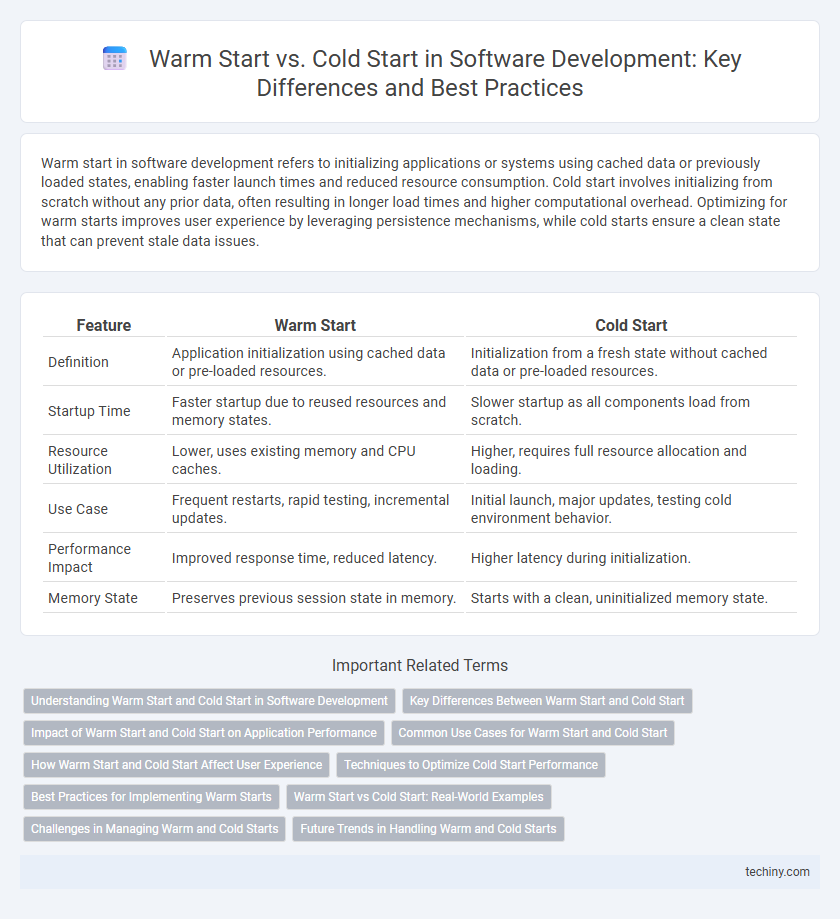Warm start in software development refers to initializing applications or systems using cached data or previously loaded states, enabling faster launch times and reduced resource consumption. Cold start involves initializing from scratch without any prior data, often resulting in longer load times and higher computational overhead. Optimizing for warm starts improves user experience by leveraging persistence mechanisms, while cold starts ensure a clean state that can prevent stale data issues.
Table of Comparison
| Feature | Warm Start | Cold Start |
|---|---|---|
| Definition | Application initialization using cached data or pre-loaded resources. | Initialization from a fresh state without cached data or pre-loaded resources. |
| Startup Time | Faster startup due to reused resources and memory states. | Slower startup as all components load from scratch. |
| Resource Utilization | Lower, uses existing memory and CPU caches. | Higher, requires full resource allocation and loading. |
| Use Case | Frequent restarts, rapid testing, incremental updates. | Initial launch, major updates, testing cold environment behavior. |
| Performance Impact | Improved response time, reduced latency. | Higher latency during initialization. |
| Memory State | Preserves previous session state in memory. | Starts with a clean, uninitialized memory state. |
Understanding Warm Start and Cold Start in Software Development
Warm start in software development refers to initializing an application or system using cached data or preserved state, enabling faster loading times and reduced computational overhead. Cold start occurs when the system initializes from scratch without prior cached information, often resulting in longer startup latency and increased resource consumption. Understanding the differences between warm start and cold start is crucial for optimizing performance, especially in cloud services, serverless computing, and application deployment scenarios.
Key Differences Between Warm Start and Cold Start
Warm start in software development involves initializing an application using previously saved state or cached data, significantly reducing startup time and resource consumption. Cold start requires loading all components from scratch without any pre-existing state, leading to longer initialization periods and higher computational overhead. The key differences include startup latency, resource usage, and user experience impact, with warm starts optimizing performance and cold starts ensuring a clean and predictable environment.
Impact of Warm Start and Cold Start on Application Performance
Warm start significantly enhances application performance by reducing initialization time and resource consumption, leading to faster response and improved user experience. In contrast, cold start incurs higher latency due to full environment setup, causing slower application startup and potential delays under high traffic. Optimizing warm start strategies is critical for applications requiring rapid scaling and low-latency responses.
Common Use Cases for Warm Start and Cold Start
Warm start is commonly used in software development scenarios requiring rapid deployment and iterative improvement, such as continuous integration pipelines and real-time data processing systems, where retaining previous state accelerates system readiness. Cold start is essential for initial application launches, instances involving serverless functions with no cached context, and large-scale batch processing jobs where starting from a clean slate ensures data consistency and prevents state-related errors. Choosing between warm start and cold start significantly impacts performance optimization in cloud environments, microservices architecture, and machine learning model initialization workflows.
How Warm Start and Cold Start Affect User Experience
Warm start significantly enhances user experience by reducing app launch time, enabling quicker access to features as the system retains necessary resources in memory. Cold start causes longer wait times since the device must initialize the app and load all components from scratch, often resulting in frustration and decreased user satisfaction. Optimizing warm start processes improves responsiveness and seamless interaction, which are critical metrics in software development performance.
Techniques to Optimize Cold Start Performance
Techniques to optimize cold start performance in software development include ahead-of-time (AOT) compilation, which reduces runtime initialization by compiling code before execution, and lazy loading to defer loading non-essential components until needed. Utilizing serverless platforms with provisioned concurrency minimizes cold start latency by keeping functions initialized and ready to respond. Efficient dependency management and resource caching further enhance startup speed by reducing the overhead of loading external libraries and data during initialization.
Best Practices for Implementing Warm Starts
Implementing warm starts in software development requires efficient state preservation techniques such as snapshotting critical data to minimize startup latency and avoid full system reloads. Developers should leverage persistent caches and lightweight initialization processes to ensure faster recovery while maintaining system integrity. Regular validation of saved states and robust error handling are essential to prevent corrupted data causing failures during the warm start process.
Warm Start vs Cold Start: Real-World Examples
Warm start in software development allows applications to resume quickly by reusing existing resources, as seen in serverless functions maintaining container instances for faster response times. Cold start requires initializing all components from scratch, which is common in cloud services like AWS Lambda when no prior instances are available, leading to higher latency. Real-world examples include mobile apps using warm start to reload states instantly, while cloud deployment pipelines experience cold starts during initial setup phases.
Challenges in Managing Warm and Cold Starts
Managing warm and cold starts in software development presents challenges including balancing resource allocation to minimize latency while preventing excessive resource consumption. Warm starts reduce initialization time by reusing previously loaded components, but maintaining these active services increases operational costs and complexity. Cold starts, although resource-efficient by initializing services on demand, often lead to higher latency and degraded user experience during startup phases.
Future Trends in Handling Warm and Cold Starts
Future trends in handling warm and cold starts in software development emphasize improved caching algorithms and preloading techniques to minimize latency and optimize resource utilization. Advances in artificial intelligence and machine learning enable predictive loading, allowing systems to anticipate user behavior and initiate warm starts seamlessly. Edge computing and serverless architectures contribute to faster cold start times by distributing workloads closer to end-users and leveraging lightweight containerization.
Warm Start vs Cold Start Infographic

 techiny.com
techiny.com